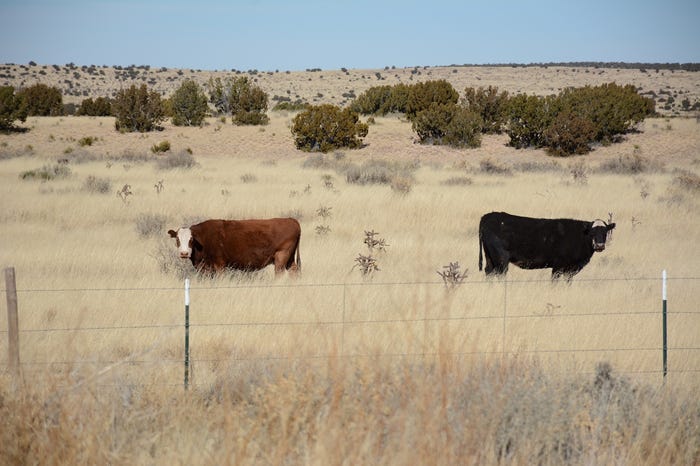Road trip of cow country west
Roundabout trip from Oklahoma to Phoenix and back offered here in a picture gallery.

South of Corona, in central New Mexico, these cows were part of a small group grazing hear Highway 54.Alan Newport
One of the things I try to do on a regular basis is get out and look at the countryside and at cattle across a wide area so I have a feel for the pulse of the business.
I have been weak in that respect the past year or so, and therefore I made my trip to NCBA in Phoenix a road trip with some stops along the way to look at ranches and cattle. Some of my appointments just fell through, as meetings sometimes do, with flu season and busyness as the reasons, but it was a good trip with some interesting scenery I believe you might enjoy.
For those who have never traveled far into the West, my reflections from this trip and previous ones are that the farther West you go the drier things get and the further is the space between trees, plants, animals and people. That has become moreso for grazing animals such as cattle over the past century, and also for people where they actually still draw their living from the land. The distances are great, and the ability to judge those distances for the eastern eye is quaintly inept. There is nothing in the west to help you judge the great distances, except to know whatever you look at is farther than it seems.
The size of a cow, of course, is relatively the same, but the farther west one goes the fewer cows one sees. In fact, from the time I neared Alamogordo as I traveled southwest across New Mexico, there was nary a cow on the landscape, despite the fact my view was well over two miles in most directions most of the time.
This follows the findings of all my studies, which say the native stocking rate of North America has never improved since our European ancestors arrived and began continuous stocking. It has only declined. And it has declined the most in these arid, frangible environments.
Certainly this was the case in the basin surrounding Willcox, Arizona, where I stopped to spend a morning with Allan Crockett, the ranch management consultant who teaches sometimes for Dave Pratt's Ranching for Profit school. Crockett grew up north of the basin, across the mountains, but says the locals say the basin once was home to more than one million cattle, and maps of the region say Willcox was considered a national leader in cattle production in the early 1900s. The 2012 Census of Agriculture showed there were 56,725 total cattle and calves in all of Cochise County, Arizona, and the statewide total is now less than a million cattle and calves.
I never saw a single bovine in the desert from there to Phoenix. Traveling east of Flagstaff cattle appeared rarely. Until I again reached mid-New Mexico I did not see significant numbers. I interpret their infrequency in my eyesight, together with the wide spacing of grass and other forage plants, to imply an extremely sparse stocking rate, which the available data again supports.
About the Author(s)
You May Also Like


.png?width=300&auto=webp&quality=80&disable=upscale)
